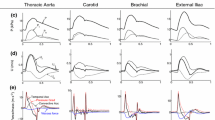Abstract
The parameters of wave intensity analysis are calculated from incremental changes in pressure and velocity. While it is clear that forward- and backward-traveling waves induce incremental changes in pressure, not all incremental changes in pressure are due to waves; changes in pressure may also be due to changes in the volume of a compliant structure. When the left ventricular ejects blood rapidly into the aorta, aortic pressure increases, in part, because of the increase in aortic volume: aortic inflow is momentarily greater than aortic outflow. Therefore, to properly quantify the effects of forward or backward waves on arterial pressure and velocity (flow), the component of the incremental change in arterial pressure that is due only to this increase in arterial volume—and not, fundamentally, due to waves—first must be excluded. This component is the pressure generated by the filling and emptying of the reservoir, Otto Frank’s Windkessel.









Similar content being viewed by others
References
Alexander RS (1953) The genesis of the aortic standing wave. Circ Res 1:145–151
Arts T, Kruger RTI, van Greven W, Lambregts JAC, Reneman RS (1979) Propagation velocity and reflection of pressure waves in the canine coronary artery. Am J Physiol Heart Circ Physiol 237:H469–H474
Bers DM (2001) Excitation–contraction coupling and cardiac contractile force. Kluwer Academic Press, Dordrecht
Davies JE, Manisty CH, Hadjiloizou N, Aguado-Sierra J, Malik IS, Foale RA, Hughes AD, Mayet J (2008) A unifying explanation of the aortic pressure waveform in humans. J Am Coll Cardiol 49:397A–398A.2007
Davies JE, Whinnett ZI, Francis DP, Manisty CH, Aguado-Sierra J, Willson K, Foale RA, Malik IS, Hughes AD, Parker KH, Mayet J (2006) Evidence of a dominant backward-propagating “suction” wave responsible for diastolic coronary filling in humans, attenuated in left ventricular hypertrophy. Circulation 113:1768–1778. doi:10.1161/CIRCULATIONAHA.105.603050
Davis MJ, Ferrer PN, Gore RW (1986) Vascular anatomy and hydrostatic pressure profile in the hamster cheek pouch. Am J Physiol 250:H291–H303
Flewitt JA, Hobson TN, Wang J Jr, Johnston CR, Shrive NG, Belenkie I, Parker KH, Tyberg JV (2007) Wave intensity analysis of left ventricular filling: application of windkessel theory. Am J Physiol Heart Circ Physiol 292:H2817–H2823. doi:10.1152/ajpheart.00936.2006
Frank O (1899) Die Grundform des Arteriellen Pulses. Erste Abhandlung. Mathematische Analyse. Z Biol 37:483–526
Khir AW, O’Brien A, Gibbs JSB, Parker KH (2001) Determination of wave speed and wave separation in the arteries. J Biomech 34:1145–1155. doi:10.1016/S0021-9290(01)00076-8
Lighthill MJ (1978) Waves in fluids. Cambridge University Press, Cambridge
McDonald DA (1955) The relation of pulsatile pressure to flow in arteries. J Physiol 127:533–552
Murgo JP, Westerhof N, Giolma JP, Altobelli SA (1980) Aortic input impedance in normal man: relationship to pressure wave forms. Circulation 62:105–116
Nichols WW, O’Rourke MF (2005) McDonald’s blood flow in arteries. Oxford University Press, New York
Parker KH (2008) An introduction to wave intensity analysis. Med Biol Eng Comput
Parker KH, Jones CJH (1990) Forward and backward running waves in the arteries: analysis using the method of characteristics. J Biomech Eng 112:322–326. doi:10.1115/1.2891191
Parker KH, Jones CJH, Dawson JR, Gibson DG (1988) What stops the flow of blood from the heart? Heart Vessels 4:241–245. doi:10.1007/BF02058593
Peterson LH (1954) The dynamics of pulsatile blood flow. Circ Res 2:127–139
Remington JW, O’Brien LJ (1970) Construction of aortic flow pulse from pressure pulse. Am J Physiol 218:437–447
Sagawa K, Lie RK, Schaefer J (1990) Translation of Otto Frank’s paper “Die Grundform des Arteriellen Pulses” Zeitschrift fur Biologie 37:483–526 (1899). J Mol Cell Cardiol 22:253–277. doi:10.1016/0022-2828(90)91459-K
Sun Y-H, Anderson TJ, Parker KH, Tyberg JV (2000) Wave-intensity analysis: a new approach to coronary dynamics. J Appl Physiol 89:1636–1644
Tyberg JV, Shrive NG, Bouwmeester JC, Parker KH, Wang JJ (2008) The reservoir–wave paradigm: potential implications for hypertension. Curr Hypertens Rep 4:203–212. doi:10.2174/157340208785132572
Wang JJ, Flewitt JA, Shrive NG, Parker KH, Tyberg JV (2006) Systemic venous circulation. Waves propagating on a windkessel: relation of arterial and venous windkessels to systemic vascular resistance. Am J Physiol Heart Circ Physiol 290:H154–H162. doi:10.1152/ajpheart.00494.2005
Wang JJ, O’Brien AB, Shrive NG, Parker KH, Tyberg JV (2003) Time-domain representation of ventricular–arterial coupling as a windkessel and wave system. Am J Physiol Heart Circ Physiol 284:H1358–H1368
Wang JJ, Shrive NG, Parker KH, Tyberg JV (2008) Effects of vasoconstriction and vasodilatation on LV and segmental circulatory energetics. Am J Physiol Heart Circ Physiol 294:H1216–H1225. doi:10.1152/ajpheart.00983.2007
Wang Z, Jalali F, Sun YH, Wang JJ, Parker KH, Tyberg JV (2005) Assessment of left ventricular diastolic suction in dogs using wave-intensity analysis. Am J Physiol Heart Circ Physiol 288:H1641–H1651. doi:10.1152/ajpheart.00181.2004
Westerhof N, Elzinga G, Sipkema P (1971) An artificial arterial system for pumping hearts. J Appl Physiol 31:776–781
Westerhof N, Sipkema P, van den Bos GC, Elzinga G (1972) Forward and backward waves in the arterial system. Cardiovasc Res 6:648–656. doi:10.1093/cvr/6.6.648
Womersley JR (1955) Method for the calculation of velocity, rate of flow and viscous drag in arteries when the pressure gradient is known. J Physiol 127:553–563
Author information
Authors and Affiliations
Corresponding author
Rights and permissions
About this article
Cite this article
Tyberg, J.V., Davies, J.E., Wang, Z. et al. Wave intensity analysis and the development of the reservoir–wave approach. Med Biol Eng Comput 47, 221–232 (2009). https://doi.org/10.1007/s11517-008-0430-z
Received:
Accepted:
Published:
Issue Date:
DOI: https://doi.org/10.1007/s11517-008-0430-z




